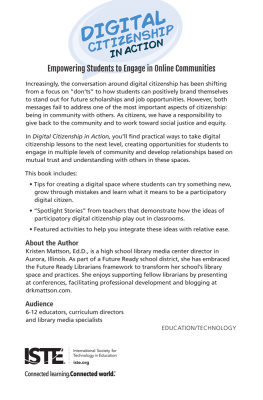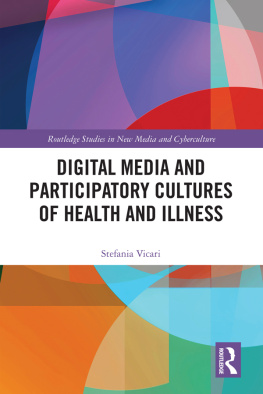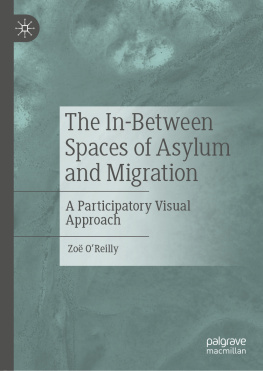Participatory Visual and Digital Research in Action
Participatory Visual and Digital Research in Action
EDITED BY
Aline Gubrium, Krista Harper, and Marty Otaez
First published 2015 by Left Coast Press, Inc.
Published 2016 by Routledge
2 Park Square, Milton Park, Abingdon, Oxon OX14 4RN
711 Third Avenue, New York, NY 10017, USA
Routledge is an imprint of the Taylor & Francis Group, an informa business
Copyright 2015 Taylor & Francis
All rights reserved. No part of this book may be reprinted or reproduced or utilised in any form or by any electronic, mechanical, or other means, now known or hereafter invented, including photocopying and recording, or in any information storage or retrieval system, without permission in writing from the publishers.
Notice:
Product or corporate names may be trademarks or registered trademarks, and are used only for identification and explanation without intent to infringe.
Library of Congress Cataloging-in-Publication Data
Participatory visual and digital research in action / edited by Aline Gubrium, Krista Harper, and Marty Otaez.
pages cm
Includes bibliographical references and index.
ISBN 978-1-62958-054-8 (hardback : alk. paper) -- ISBN 978-1-62958-055-5 (pbk. : alk. paper) -- ISBN 978-1-62958-056-2 (institutional ebool -- ISBN 978-1-62958-057-9 (consumer ebook)
1. Visual anthropology--Case studies. 2. Visual sociology--Case studie 3. Video recording in ethnology--Case studies. 4. Motion pictures in ethnology--Case studies. I. Gubrium, Aline. II. Harper, Krista. III.
Otaez, Marty.
GN347.P38 2015
301--dc23
2015011604
ISBN 978-1-62958-054-8 hardback
ISBN 978-1-62958-055-5 paperback
by Phillip Vannini
Aline Gubrium, Krista Harper, and Marty Otaez
Darcy Alexandra
Marty Otaez and Andrs Guerrero
Ciann Wilson and Sarah Flicker
Cynthia Selin and Gretchen Gano
Charles R. Menzies
Jean Schensul and Campbell Dalglish
Nicholas A. Rattray
Simona L. Perry
Edward Gonzlez-Tennant
Catherine Besteman
Madeleine Tudor and Alaka Wali
Natalie M. Underberg-Goode
Nancy Fried Foster
Elizabeth Chin, Morgan Marzec, Cayla McCrae, and Tina Zeng
Matthew Durington, Samuel Gerald Collins, and the 2014 Anthropology by the Wire Collective
Phillip Vannini
I was profoundly surprised when I received the editors invitation to write a foreword for this book. More than surprised, I admit that I felt like an impostor. My ethnographic work has nearly always been visual and digital. Yet, I never thought of it as sufficiently participatory or action-oriented.
For example, to generate interesting and at times even entertaining public knowledge, my hybrid media ethnographies (e.g., ferryresearch.ca; lifeoffgrid.ca) have used digital sound, photography, and video not so much as illustrations for journal articles, but rather as the narrative basis for publications in popular magazines, the Internet, TV, and newspapers. Knowledge mobilization of this kind, I have always thought, is necessary for raising awareness and molding public opinions, but perhaps it falls short of being action-oriented. Furthermore, even though I have always involved research participants in the editing of their visual representations (who would want their face or home in the national news if their depiction isnt fair or accurate, right?), I have always been cautious about calling that a form of collaboration.
But impostor syndrome or not, because I have always felt a deep antipathy toward traditional ways of doing and especially sharing research (e.g., see publicethnography.net), and a great deal of antagonism toward the structural academic bias for methodological conservativism, I agreed to write a few opening and perhaps apologetic words as I looked forward to catching up with the latest developments in this field.
As I write these words nowafter having read this wonderfully thorough bookI realize that I have been conducting visual, digital, and action-oriented participatory research for the last few years, much to my ignorance. My feeling is that this volume will have a similar converting effect on many other readers. And indeed I can only hope that it will do so because, in all honesty, for anyone in the twenty-first century to be convinced of the value of doing inaction-oriented, analog, nonvisual, and uncollaborative research is to be trapped in a time warp of frightening proportions.
From digital storytelling and Photovoice to participatory film and collaborative mapping, and from participatory geographic information systems (PGIS) to collaborative digital archive and museum curation (and more), the contributors to Participatory Visual and Digital Research in Action share enough inspiring tools to convince anyonefrom the already initiated to the skeptics still keen on paper-and-pencil measuresto pick up a few new skills and evaluate the potential of these evolving methodological traditions for the achievement of both old and new research objectives.
As a cynic by birthright and a critical and reflexive mind by trade, I view the immense appeal of action-oriented participatory visual and digital research strategies less in the shiny glitter that makes them new and edgy (i.e., their technological sophistication and their democratic commitment) and more in the way they allow us to take pleasure in the delight of enchantment.
In fact, there isnt enough enchantment in the world of research: there isnt enough respectin other wordsfor the naivet, wonder, and curiosity that drives (and should drive) all forms of inquiry in the first place. Enchantment is, regrettably, beaten out of us at every turn. Research professionals caught in the insidious mechanics of the neoliberal state have their enchantment chastised out of them every time they write a grant proposal that asks them to spell out in advance what they are going to find out, much like undergraduate and graduate students are confined to defending the impracticalities and romantic visions of their research designs before they embark on thesis or dissertation research. Enchantment, the institution tells us, is unnecessary, childish, biasing, impractical, and even frightening.













